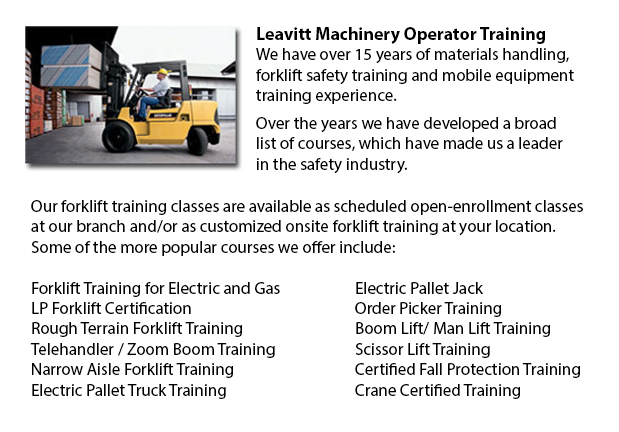
Hyster Forklift Training Markham - As a world leader in forklift trucks, Hyster continually strives for excellence in product quality and safety. However, it began as a manufacturer of lifting machines as well as winches. Most of its production was focused in the northwest United States and dealt mostly with the timber and logging industry. A couple years after the 1st forklift trucks were invented Hyster became synonymous with quality manufacturing. Over the preceding eighty years Hyster has continued to expand and grow its product line. The expansion of its products coupled with its wish to stay service oriented has allowed Hyster to develop into the intercontinental participant it is in the present day.
Some of the major inflection points in Hyster's past occurred between the 1940's and the 1960's. In 1946, Hyster opened a plant in Illinois that was entirely devoted to bulk producing trucks. This allowed Hyster to drive its costs down and, simultaneously, offer a better quality product at industry competitive prices. In 1952, Hyster began its first foray in to the international production market through opening its first plant in the Netherlands. The Netherlands plant was originally designed to produce two products: Hyster 40" and the Karry Kranes.
The forever changing needs of Hyster users and Hyster's talent to continue to innovate led to rapid growth throughout the fifties and sixties. They started constructing container handlers in the United states in 1959 to satisfy the ever growing demand for transportation goods. In 1966, Hyster developed a process for allowing a lift truck to go both ahead and backwards using the same pedal. This pedal was termed the Monotrol pedal, which revolutionized the industry. Later on in the decade Hyster opened a R and D centre in Oregon that was focused on enhancing the design and functionality of lift trucks. The centre is still one of the world's greatest testing facilities in the materials handling industry.
In the 1960's Hyster experienced rapid expansion. Much of the business was shifting in the direction of bulk production. To keep up with the times Hyster was inclined to concentrate on the evolution of these mass markets. Consequently, in 1970, the XL design philosophy was born. The XL design philosophy allowed Hyster to offer greater quality at a more affordable cost. A further expansion in production capabilities was necessitated by the need in Europe for Internal Combustion Engine Trucks. To plug this gap, a plant in Craigavon, Ireland was opened in 1980. Through the 80's Hyster continued to focus on developing industry leading lift trucks. The Hyster brand name was known throughout the globe for its commitment towards quality. This attention to excellence brought a lot of suitors for the company. In 1989, a large multinational company based in Ohio called NACCO Industries bought Hyster and began an aggressive expansion strategy. NACCO quickly changed the XL philosophy with a more driver oriented forklift that focused on operator comfort, which is identified as the XM generation of lift trucks.
With the overall shift towards just-in-time administration methods, Hyster has been required to keep up with the trends through investment in new and diverse technologies. Acquisitions and investments were made in the US, Italy, Netherlands, and a lot of other places throughout the world. All of these investments have made Hyster a worldwide leader in the forklift market. In 2009, Hyster celebrated its 80th anniversary as an industry leader of materials handling equipment, which includes more than 300 various types of forklift trucks.
-
Rough Terrain Forklifts
Rough Terrain Forklifts Training Markham - There are essentially two kinds of lift trucks within the manufacturing business, the rough terrain model and the industrial version. Rough terrain lift trucks appeared in the 1940's intended predominantly f... More -
Pneumatic Forklifts
Pneumatic Forklifts Training Markham - Widely utilized in shipping plants, the pneumatic forklift or pallet vehicle, can be used to transfer resources that are positioned onto pallets. A pneumatic lift truck commonly has a pair of steel blades instal... More -
JLG Telehandler
JLG Telehandler Training Markham - In the late 1960's John L. Grove, with his wife Cora embarked on on a cross country trip in their RV. Freshly retired, after spending several years working with his brother to develop their crane business into an ma... More -
Aerial Lifts
Aerial Lift Training Markham - Aerial jacks are able to accommodate numerous duties involving high and hard reaching spaces. Normally used to carry out routine preservation in buildings with tall ceilings, prune tree branches, hoist heavy shelving un... More -
Scissor Pallet Trucks
Scissor Pallet Truck Training Markham - Scissor lift pallet vehicles are created to have the ability to move and stack pallets with a built-in lifting apparatus that permits the pallets to be elevated. This apparatus is incredibly functional for work... More

Forklift Certification Markham
TOLL FREE: 1-888-254-6157
Markham, Ontario
forkliftcertificationmarkham.com
Email Us
About Us


